
Duolingo English Test® vs. the TOEFL iBT®
Author

Your dream is to study abroad, but the entire process is a massive headache. You have to fill out applications, research visa requirements, and prepare for exams.
One common requirement is an English language proficiency exam. You have probably heard about the TOEFL iBT® before, but there is a chance you might be able to take a new test: the Duolingo English Test®.
Which test is easier? Which test is cheaper? Which test is a better fit for you? We are going to answer these questions and more right now.
This is our in-depth guide only for international students, which means we are not going to talk about the history of each exam or how to teach them. Instead, we are going to focus on the things you need to know so you can move abroad and become an international student as quickly and as easily as possible. Let’s do it.
Duolingo English Test®vs. the TOEFL iBT®: Top 10 Questions
- Which is easier: the TOEFL iBT or the Duolingo English Test?
- What is the downside of the Duolingo English Test?
- Am I allowed to take the Duolingo English Test?
- The Scoring System: TOEFL iBT vs. The Duolingo English Test
- Which test is cheaper?
- The Speaking Section: TOEFL iBT vs. The Duolingo English Test
- The Writing Section: TOEFL iBT vs. The Duolingo English Test
- The Reading Section: TOEFL iBT vs. The Duolingo English Test
- The Listening Section: TOEFL iBT vs. The Duolingo English Test
- Which test do you recommend?
Which is easier: the TOEFL iBT or the Duolingo English Test?
Well, in theory, each test equally measures your English proficiency. If you look at the scoring table below, you can see your score across multiple exams, which implies that no matter which test you take, your result will reflect your current English ability, so, it is a myth to believe that one exam is easier than the other.
Score Conversion Table |
|||
|---|---|---|---|
| Duolingo English Test | TOEFL | IELTS Academic | CEFR |
| 160 | 120 | 8.5-9 | C2 |
| 155 | 119 | 8 | C1 |
| 150 | 117-118 | ||
| 145 | 113-116 | 7.5 | |
| 140 | 109-112 | ||
| 135 | 104-108 | 7 | |
| 130 | 98-103 | ||
| 125 | 93-97 | 6.5 | B2 |
| 120 | 87-92 | ||
| 115 | 82-86 | 6 | |
| 110 | 76-81 | ||
| 105 | 70-75 | 5.5 | |
| 100 | 65-69 | ||
| 95 | 59-64 | 5 | B1 |
| 90 | 53-58 | ||
| 85 | 47-52 | ||
| 80 | 41-46 | ||
| 75 | 35-40 | 4.5 | |
| 70 | 30-34 | ||
| 65 | 24-29 | ||
| 10-60 | 0-23 | 0-4 | A1-A2 |
But let me disagree with myself for a minute…
While your score across multiple tests will reflect the same English proficiency level, there are aspects of the Duolingo English Test that make it a less stressful experience than the TOEFL iBT.
- Shorter reading passages. There is only one question type on the Duolingo English Test that includes reading passages: the Read and Complete Question type. At most, these passages are no longer than 150 words. Compare this to the TOEFL that requires you to read three long academic passages, each clocking in at approximately 700 words.
Duolingo Example:

TOEFL Example

- A shorter test. The updated version of the TOEFL iBT lasts just two hours now (it used to be four hours). The Duolingo English Test takes just an hour.
- There are only ten total question types in the Duolingo English Test, which you can learn about here. This makes it easier to learn about and prepare for. Just for a quick comparison, there are ten total question types in the TOEFL Reading section of the TOEFL iBT, and there are plenty of other question formats in the other three sections.
Neither the TOEFL iBT nor the Duolingo English Test is easier than the other, but the ladder delivers a simpler test experience.
What is the downside of the Duolingo English Test?
As you continue to read, you will find that the Duolingo English Test is shorter and cheaper than the TOEFL iBT, so you might think that the decision is a no-brainer.
Not so fast.
Remember that the Duolingo English Test is relatively new. The TOEFL test has been around since 1964 and is accepted by every single university in the United States. The TOEFL iBT has the history and research to back up the test’s validity, so administrators trust the results of the test.
The Duolingo English Test has been around for about five years and only recently became widely accepted in universities across the US and Canada. In other words, the TOEFL iBT’s reputation is far stronger than the Duolingo English Test.
Am I allowed to take the Duolingo English Test?
Some students are not sure whether or not they can actually choose between these two exams. You will have to check with your institution for confirmation. You can find a list of all the schools accepting the Duolingo English Test right here.
Note that most universities in North America and Canada now accept the Duolingo English Test for admission. In terms of student visas, however, one notable exception is the Student Direct Stream program in Canada, which now accepts IELTS, TOEFL, and PTE scores. Institutions in Asia and Europe most likely will not accept the Duolingo English Test as a valid proficiency exam.
The same holds true for professional licenses that require an English proficiency score, nearly all have neglected to include the Duolingo English Test to their list of acceptable proficiency exams.
The scoring system: TOEFL iBT vs. the Duolingo English Test
The TOEFL iBT is pretty straightforward. There are four sections in the exam and each section is graded up to 30 points. The highest possible grade you can earn on the TOEFL iBT is 120.
- Reading Section: 30
- Listening Section: 30
- Speaking Section: 30
- Writing Section: 30
While the Duolingo English Test is a simpler exam to understand, the scoring criteria are a bit confusing.
Why?
Well, first of all, there are no sections in the Duolingo English Test. Each of the ten question types contributes to your overall score. In the chart below, you will see how each question type is scored.
Score Conversion Table |
|||
|---|---|---|---|
| Question Types | Frequency | Adaptive | Subscore |
| 01. Read and Complete | 5-7 | ◯ | Comprehension, Literacy |
| 02. Read and Select | 5-7 | ◯ | Comprehension, Literacy |
| 03. Listen and Select | 5-7 | ◯ | Comprehension, Literacy |
| 04. Listen and Type | 5-7 | ◯ | Comprehension, Literacy |
| 05. Read Aloud | 5-7 | ◯ | Comprehension, Literacy |
| 06. Write About the Photo | 3 | X | Literacy, Production |
| 07. Read, Then Write | 1 | X | Literacy, Production |
| 08. Speak About the Photo | 1 | X | Conversation, Production |
| 09. Read, Then Speak | 1 | X | Conversation, Production |
| 10. Listen, Then Speak | 1-2 | X | Conversation, Production |
You have probably noticed that the scores are not separated based on reading, listening, speaking, and writing, like the TOEFL or IELTS exams. The creators of the Duolingo English Test believe these skills are integrated and should be graded in a way to reflect this idea. When you receive your score report, you will have an overall score out of 160, which is an average of each of your subscores.
Overall Score: 160:
- Literacy (read and write): 160
- Comprehension (read and listen): 160
- Conversation (listen and speak): 160
- Production (write and speak): 160
Check out the example of a student score report below to get a better idea of how your results might look.
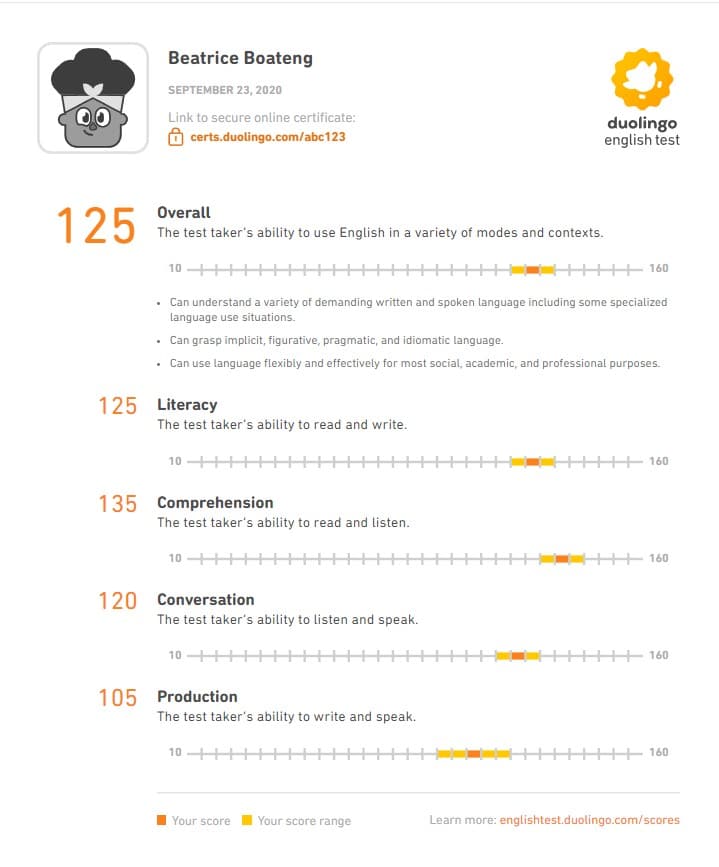
Which test is cheaper?
The Duolingo English Test costs $59 and you can register here, while the TOEFL iBT costs over $200, but the price does vary a bit depending on your location, so check the exact amount here.
The speaking section: TOEFL iBT vs. the Duolingo English Test
In the TOEFL iBT, you will be asked four questions, one independent question that asks for your opinion and three integrated questions where you report on the information you read or saw. For question one, you will be required to speak for 45 seconds, and questions two, three, and four will ask you to respond for 60 seconds.
You can see an example of a typical TOEFL iBT Speaking section experience in this video.
You are allowed to take notes and you will have between 15-30 seconds to prepare, depending on the question. Most students find questions three and four the most challenging because they must listen to a short lecture and report on the academic topic.
The Duolingo English Test is not separated based on sections like the TOEFL iBT but on question types. Out of the scoring criteria, speaking is related to your conversation and production subscores. There are four questions types that directly connect to these subscores:
a. Read Aloud
You can expect about six of these questions on test day. You will be provided with a sentence and you have to read it aloud.
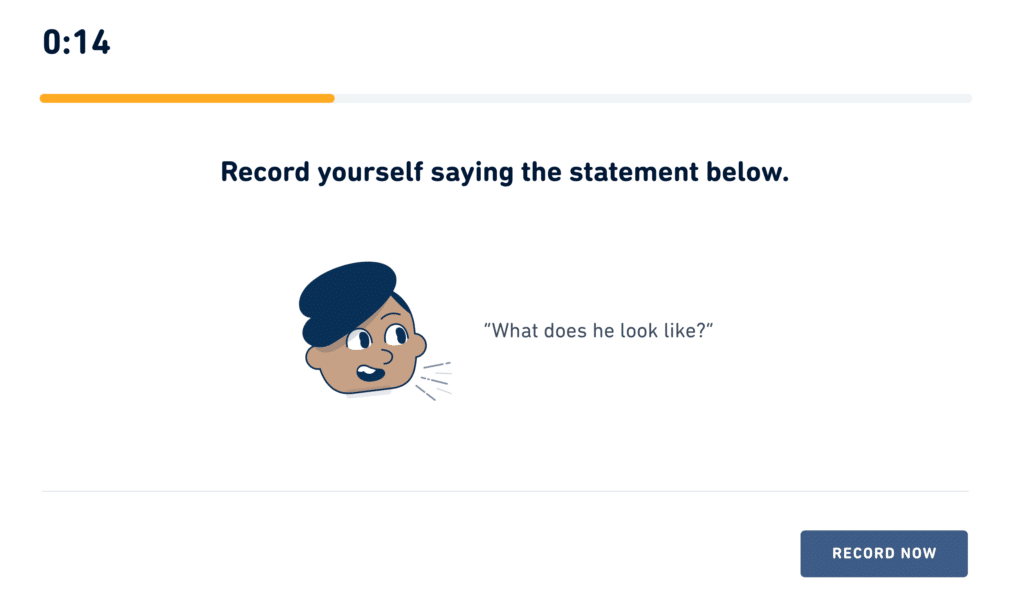
b. Speak about the Photo
You will have one question where you are presented with an image and must speak about it for 30-90 seconds.

c. Read, Then Speak
This question will ask for your opinion or to describe a general topic for 30-90 seconds. You will have just one of this question type.

d. Listen, Then Speak
This question will show up once or twice on test day. Instead of reading a question, you only listen and then speak between 30-90 seconds.
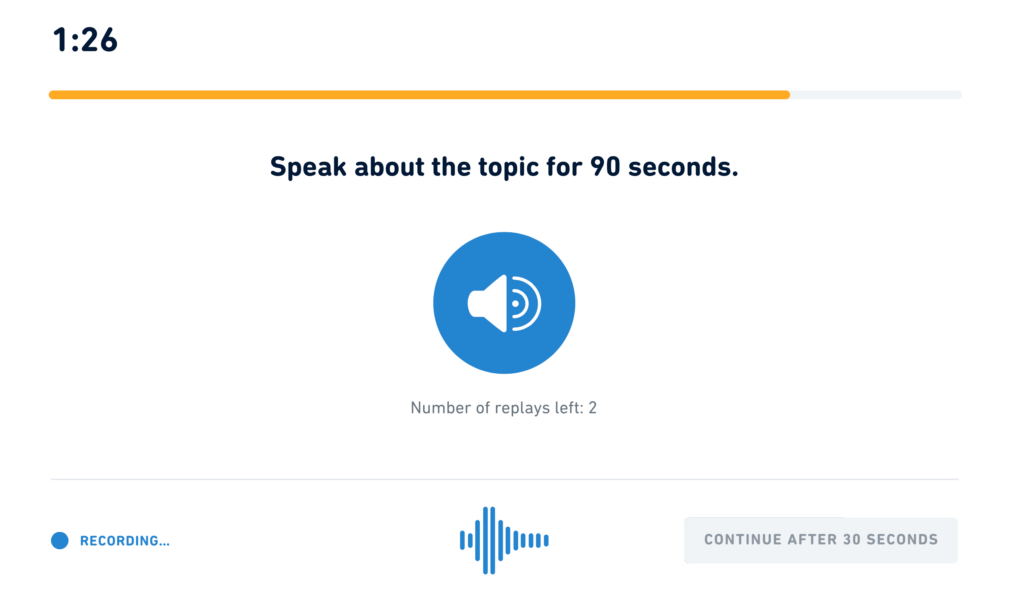
While some students are relieved that the Duolingo English Test does not require you to speak about an academic topic, others find these types of questions more difficult. If you want to score high, it is better to speak for as long as possible. Many struggle to find things to say about a single image for close to 90 seconds.
The bottom line? The speaking requirements for both the Duolingo English Test and the TOEFL iBT are challenging.
The writing section: TOEFL iBT vs. the Duolingo English Test
The TOEFL iBT Writing section is similar to the Speaking section, just with fewer questions. You will be expected to write two essays: one integrated and one writing for an academic discussion.
The integrated will include a reading and listening passage about an academic topic. There is no way to predict what the topic might be. Topics could come from nearly any academic field. However, note that this is an English test, so all of the information you need to write a high-scoring essay will be included in the passages. When it comes time to write, you will have to compose a 250-word or more essay where you report on the information you read and heard.
The writing for an academic discussion question will present you with a question posed by a teacher on an online forum, followed by a response from two students. You will have ten minutes to read and write a response of at least 120 words. This is a new TOEFL Writing question type and you can learn more about it here.
You can find an example of the TOEFL iBT in the video below.
The question types associated with writing for the Duolingo English Test are Write About the Photo and Read, Then Write. These questions contribute to your literacy and production scores.
a. Write About the Photo
You will be given one minute to write about the photo provided. You will get three of these questions on test day.

b. Read, Then Write
You will only see this once on test day. Think of it as a mini-essay. You will have 5 minutes to write a description or your opinion on a general topic. You should aim to write at least 100 words.
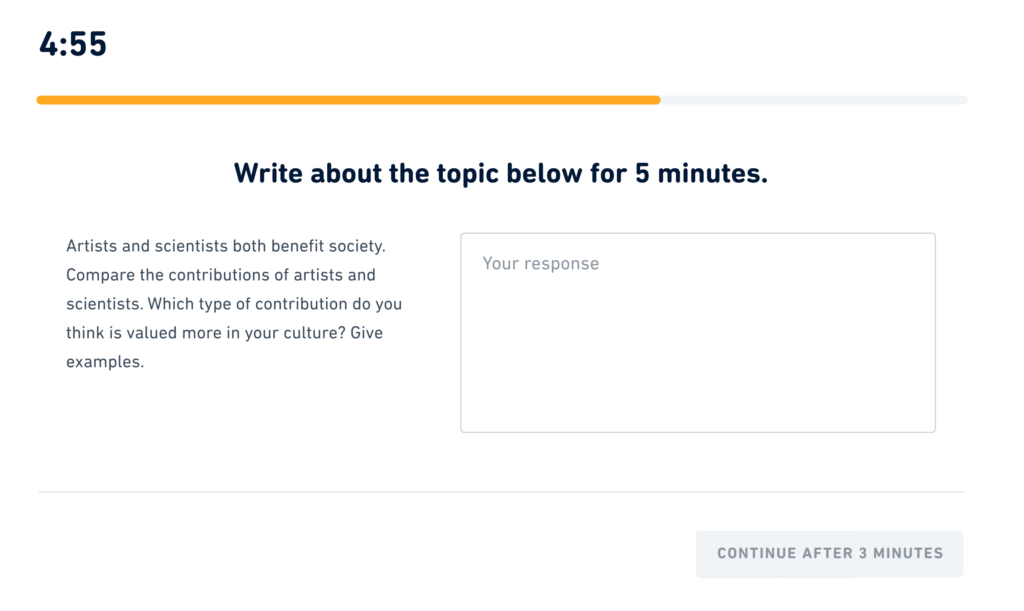
One critique I sometimes hear from colleagues about the Duolingo English Test is the lack of a formal essay. Tests like the TOEFL and IELTS ask students to write at least one essay, while the Duolingo English Tests asks for a five-minute writing sample, which results in an essay of between 50 – 200 words.
What does this all mean?
Well, when it comes to writing, you are required to do much less of it for the Duolingo English Test.
The reading section: TOEFL iBT vs. the Duolingo English Test
Some argue that the Reading section of the TOEFL iBT is the most challenging part of the exam. You are required to read two academic passages, each containing approximately 700 words, and answer ten questions about each passage within 36 minutes. Besides the rigorous time constraints, students will encounter up to ten different question types that will test their both comprehension and critical thinking skills.

In regards to the Duolingo English Test, the question types related to reading skills are Read and Complete and Read and Select, which contribute to your Comprehension and Literacy subscores.
a. Read and Complete
You will read a short passage, somewhere between 40-100 words, on a range of various topics. You must fill in between 7-18 blanks with the correct missing word.

b. Read and Select
The Read and Select question will provide a series of 18 words, both real and fake. Your job is to select the words that are real.
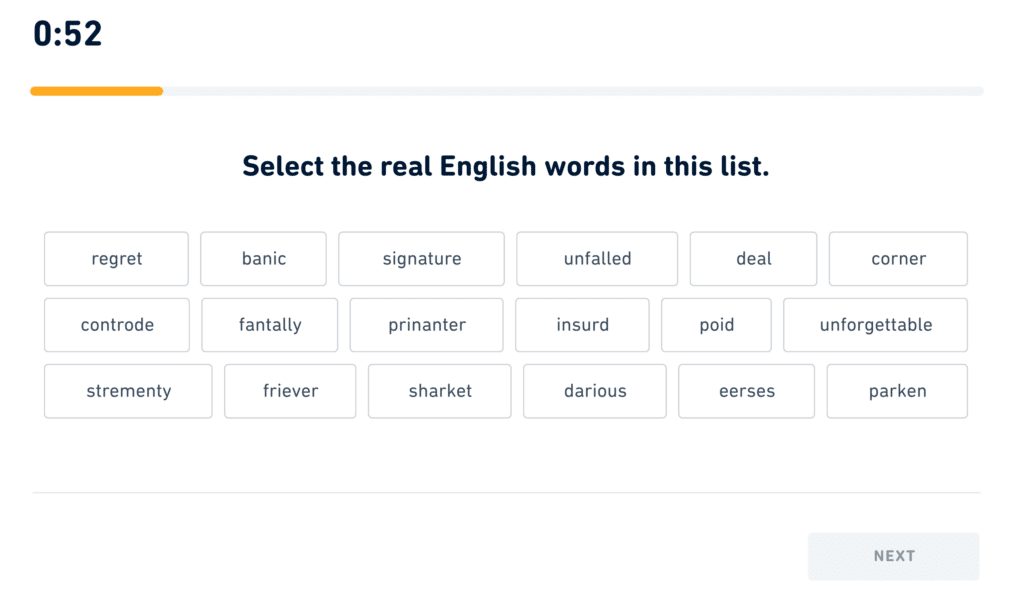
In this side-by-side comparison, it is clear to see how the Duolingo English Test is a much less stressful experience when compared to the TOEFL iBT. While some researchers like Elvis Wagner have criticized the Duolingo English Test’s lack of long-form reading passages, both tests are now commonly accepted at most universities and the reading requirements are far less intensive on Duolingo’s exam.
The listening section: TOEFL iBT vs. the Duolingo English Test
The Listening section of the TOEFL iBT consists of two parts, five passages, and twenty-eight questions. The two conversations take place in an academic setting and last about three to four minutes. The three lectures could be on a wide range of academic topics and clock in somewhere between four to five minutes in length.
You will be expected to take notes and answer questions that test your comprehension and critical thinking skills, much like the Reading section of the TOEFL iBT.
As with the other sections of the Duolingo English Test, it is best to think in terms of question types and subscores. Listen and Select and Listen and Type questions closely resemble test items that measure your listening comprehension. These two question types are connected to your Conversation and Comprehension subscores.
a. Listen and Select
You will listen to nine isolated words and select which ones are real. It is similar to the Read and Select question types, only with fewer words and audio only.
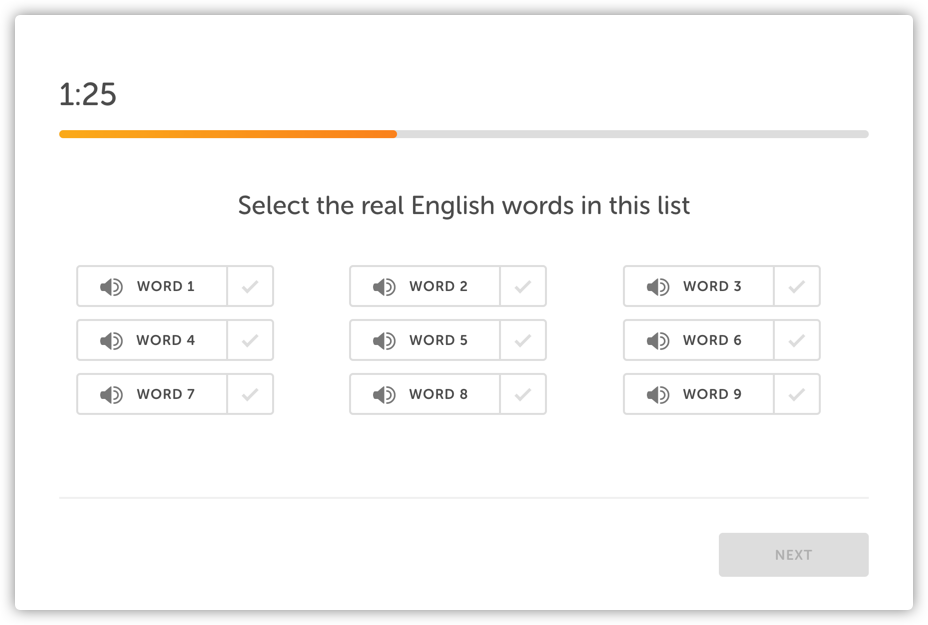
b. Listen and Type
You will listen to a sentence and type out what you hear. It sounds simple, but for longer audio files this becomes quite challenging. You are allowed to replay the passage twice.

One interesting difference between the TOEFL iBT and the Duolingo English Test is the emphasis on notetaking. For the TOEFL iBT, notetaking is a critical skill to master, especially for the Listening section. In the Duolingo English Test, you are not allowed to take notes, which forces the test items to be much shorter.
The Duolingo English Test listening tasks are far less demanding than the TOEFL iBT, in my opinion.
Which test do you recommend?
Ah, the million dollar question. I see positive and negative aspects of both exams. While the Duolingo English test is shorter and cheaper, it is also a new exam that has not been tested through time. There is a reason why the TOEFL iBT is trusted by every single university in the United States: it’s old. While old might not be cool, it is also proof of a test’s validity, so schools trust it.
Looking for more information?
If you are looking for a more extensive practice experience, create a free account at TST Prep and gain access to over 400 free practice questions.
Still, if you check Duolingo English Test’s website and find that your school accepts it for admission, then the age of the TOEFL iBT does not matter.
The choice is yours.
Also read:
Create a FREE
Practice Account
Join now and start learning with our free materials






